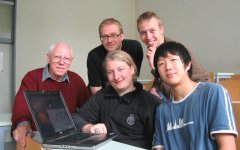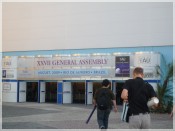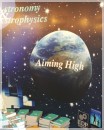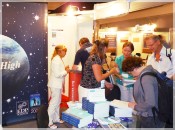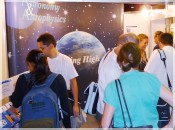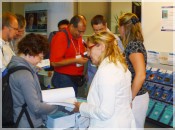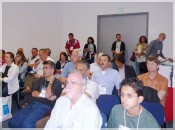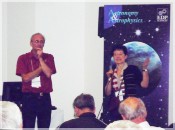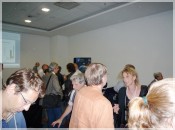News archive
GREGOR Special Issue published by A&A (November 2016)
- Details
- Published on 29 November 2016
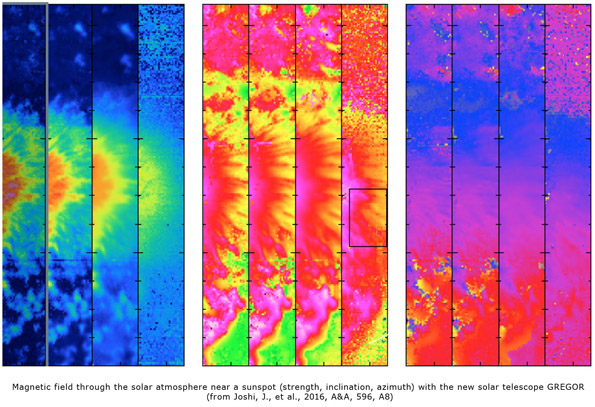
Astronomy & Astrophysics, published by EDP Sciences, has released a series of papers on the first science data from the GREGOR telescope (the largest of its kind in Europe.)
GREGOR is a solar telescope designed to observe the solar photosphere and chromosphere in the visible and the near-infrared wavelengths. Its main mirror (1.5m diameter) allows for solar images of unprecedented quality and resolution. To read Press Release click here.
To read the special issue, please click here.
A&A publishes Gaia Special Issue (November 2016)
- Details
- Published on 24 November 2016

Astronomy & Astrophysics, published by EDP Sciences, has published a special issue gathering papers describing the GAIA data release and their validation.
Gaia is an ESA mission to survey one billion stars in our Galaxy and local galactic neighbourhood in order to build the most precise 3D map of the Milky Way and answer questions about its structure, origin and evolution.
To read the special issue, please click here.
Authors can now submit directly to the A&A Journal in Writing Studio (September 2016)
- Details
- Published on 26 September 2016
Following the successful launch of Writing Studio for the authors of A&A journal, there have been further developments that now allow researchers to submit their paper to A&A via Writing Studio.
Writing Studio is a unique collaborative writing LaTex solution designed to simplify the process of writing an A&A article collaboratively on a single version of a paper. Now, A&A authors are able to use Writing Studio from the beginning of an article through to its submission.
For more information about Writing Studio please visit - http://writingstudio.aws.edpsciences.org/login.
Discontinuation of Research Notes (August 2016)
- Details
- Published on 12 August 2016
After having published Research Notes for many years, A&A has decided to discontinue this category of papers.
A&A announces its new Impact Factor is 5.185 (June 2016)
- Details
- Published on 17 June 2016

The latest Journal Citation Reports® recently announced by Thomson Reuters have revealed that Astronomy & Astrophysics’ Impact Factor has risen to 5.185*.
This confirms A&A’s position as one of the leading journals in the field, publishing the very best papers on all aspects of astronomy and astrophysics.
Click here to read the journal or to submit a paper.
*2016 Release of Journal Citation Reports. Source: 2015 Web of Science Data"
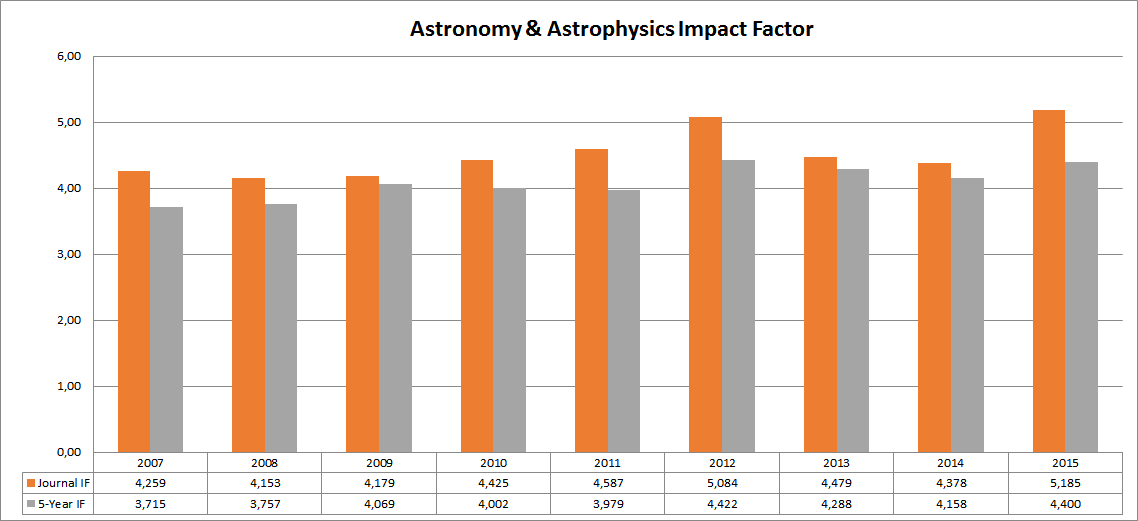
A&A Special Feature - The XXL Survey: First results (June 2016)
- Details
- Published on 03 June 2016
Astronomy & Astrophysics is pleased to announce publication of the complete version of the XXL Survey special feature. A first series of papers and a press release were issued last December, and we are now publishing the final series of twelve papers. XXL is a large survey of the X-ray sky with the XMM-Newton ESA observatory. Its goal is to detect a few hundreds of clusters at a look-back time when the age of the Universe was about half its present value. The ensemble of results published in this A&A special feature shed light on the evolutionary properties and spatial distribution of the massive structures of the universe and, subsequently, on various cosmological properties.
A&A Journal and EDP Sciences launch Writing Studio to support their authors (March 2016)
- Details
- Published on 25 March 2016

Astronomy and Astrophysics (A&A) Journal and EDP Sciences are pleased to announce the launch of Writing Studio, a unique collaborative writing LaTex solution designed to simplify the process of writing an article collaboratively on a single version of a paper. Reinforcing an open-source strategy, EDP Sciences has chosen the Open Source ShareLateX to develop this new service.
Writing Studio provides:
- A collaborative LaTeX solution: Multiple co-authors can jointly work on a single version of the paper with up-to-date A&A macros already included.
- Direct communication between co-authors: Co-authors can ask each other questions and can chat for real-time interactions.
- Dropbox integration: Articles can be edited offline and automatically synchronized with the Dropbox online copy.
- Ease of submission (coming soon): Article will be uploaded to the A&A submission system with a single click, with key fields pre-filled ready for checking.
- Easier links to astronomical objects: Authors get auto-completion for stellar objects and additional information using tools developed with the CDS.
- ORCID integration: Authors login to Writing Studio and are recognized by their ORCID iD.
The next step is to link Writing Studio with all the EDP Sciences journals and their submission systems and integrate this tool in a comprehensive LaTeX dedicated workflow, from the writing of an article through to its online publication.
Login to the Writing Studio using your ORCID iD.
Read Press Release for more information
Jean-Louis Steinberg (1922-2016) (January 2016)
- Details
- Published on 28 January 2016

in Kiev in 1974.
Copyright: Gérard Epstein, 1974
Jean-Louis Steinberg passed away in Paris on 21 January 2016, at the age of 93. He was one of the founders of radioastronomy in France and a pioneer of astronomy from space at the Paris Observatory. Last, but not least, he also played a leading role in the creation of the journal Astronomy & Astrophysics.
Jean-Louis was born on 7 June 1922, in Paris, and as a young man he began his studies to be a scientist and became a Doctor of Engineering in 1943. However, in June 1944, he was arrested and deported with his parents and one of his two brothers. He was the only survivor of the four when the US Army liberated the camp. Conscious that he was one of the last direct witnesses of the Holocaust, after his retirement he devoted much of his time to keeping the memory of the deportees alive. Right up until the last days of his life, he was providing testimonials of the horror of the concentration camps to schools and conferences.
After the WWII, he completed his studies and entered the physics laboratory of the École Normale Supérieure. This was just the start of a very successful scientific career. He also liked writing and was interested in scientific publications. In 1962, he was offered the job of Editor-in-Chief of the French journal, Annales d’Astrophysique, one of three professional journals in astronomy that were published in France at the time. He ran the journal with his wife Madeleine, who was fluent in English and Russian. In 1968, they decided to evaluate the usefulness of the work that had been carried out over the previous six years. However, when they looked up citations of the papers published in their journal in the Science citation index they were horrified to find that their journal had not even been mentioned. They concluded that English-speaking scientists were probably not reading it since it was clear, when they looked at the citations in American and English journals, that it was mostly being quoted by its own authors.
Jean-Louis shared his dismay with Stuart Pottasch, the Editor-in-Chief of the Bulletin of the Astronomical Institutes of the Netherlands, who was having a similar experience, and they began talking about merging their publications in a new international journal. They found initial support from Jan Hendrik Oort, director of the Leiden Observatory, and from Anders Reiz, director of the Copenhagen Observatory, with whom they discussed the possibility of also merging the Scandinavian journals into a new publication. Together with Jean-François Denisse, director of the Paris Observatory, Jean-Louis then called a meeting of French astronomers during the turmoil of the 1968 events. He managed to convince them to merge the three French astronomy journals into one new publication.
Meanwhile, the idea of a new international astronomical journal had also been gaining ground in Germany and Belgium, as well as in all Scandinavian countries. At a subsequent meeting of key actors, held in Leiden on March 27, 1968, the general principles for the operation of the new journal, with the proposed name, “Astronomy & Astrophysics: A European Journal”, were also discussed. ESO was then asked to provide a legal framework for the new journal and its Council responded favourably in July 1968. As a result, Astronomy & Astrophysics saw the light of day and the first issue was published in January 1969. Naturally, Jean-Louis Steinberg and Stuart Pottasch were the two first Editors-in-Chief. Jean-Louis remained in this position for five years, ensuring the huge success of the new journal.
Jean-Louis and Madeleine ran the Meudon A&A editorial office during those five years with the help of a secretary and a part-time draughtswoman. There were only four issues of the journal in 1969, but it soon became a monthly publication and one of the four major generalist astronomical journals in the world. Initially, papers were submitted in English, French or German, but it soon became clear that, for a given author, the papers in English were cited twice as often as those in other languages. As a consequence, the vast majority of papers were soon written in English and corrected, when needed, by Madeleine.
Clearly, Jean-Louis was a pioneer in European scientific publishing: astronomers were the first to succeed in merging their journals into a single publication, and the refereeing system he set up was run very smoothly. Since then, his successors have attempted to maintain the high standards he defined as best as they could.
Those of us who were privileged to know Jean-Louis Steinberg as an Editor-in-Chief will remember him as always being accessible and attentive to authors. He was a man of exceptional moral integrity, a hard worker, a visionary and a bright and charismatic scientist and editor.
James Lequeux, Claude Bertout, Nabila Aghanim, Thierry Forveille
N.B. Jean-Louis Steinberg published a detailed account of his life and activities in an article entitled “The scientific career of a team leader”, Planetary and Space Science 49 (2001) 511-522.
4th Scientific Writing for Young Astronomers 2016 (December 2015)
- Details
- Published on 21 December 2015
EDP Sciences and Astronomy & Astrophysics are glad to announce the "4th Scientific Writing for Young Astronomers", which will be held in Puerto Varas, Chile, from 19th to 22th April, 2016.
The direct purpose of organizing an “Astronomy and Astrophysics School” is to teach beginning PhD Students how to express their scientific results through correct and efficient science writing. In other words, how to write scientific papers for different forums (journals, proceedings, thesis manuscripts, etc.)
For further information, we invite you to visit our website and to like our Facebook page "Scientific Writing for Young Astronomers".
Patricio Rojo
Director of the school
Altmetric data now available in A&A papers! (November 2015)
- Details
- Published on 06 November 2015
EDP Sciences has recently added the Altmetric data for Astronomy & Astrophysics.
Altmetric data gives users a more complete picture of how people are engaging with scholarly literature by tracking a variety of sources, including news, social media, bookmarking and peer-review forums, to provide data on the online activity surrounding each research article.
Readers can click on the Altmetric badge to view the original mention and explore the news stories, tweets, blogs and more for themselves.
This data is important to both authors and readers, helping them understand the wider dissemination of research, and allows them to engage in online conversations they may not have been aware of.

See http://www.altmetric.com for more information.
A&A special feature: Results of the Rosetta mission before perihelion (November 2015)
- Details
- Published on 02 November 2015
Astronomy & Astrophysics is publishing a special feature of 46 articles that present the results obtained by the Rosetta mission before the comet 67P/Churyumov-Gerasimenko reached its perihelion.
The articles published in this A&A special feature cover a variety of themes in cometary science and revolutionize the field in many ways.
More information in Press Release here
Access directly to the Rosetta’s special feature
To benefit from 1 month free access to Rosetta special feature, register online now!*
*Access to this special feature is free to consult during 1 month to all scientists registered to the Latest Articles Free Service.
Astronomy and Astrophysics will move to online-only publication at the start of 2016 (September 2015)
- Details
- Published on 17 September 2015
Astronomy and Astrophysics (A&A) is pleased to announce that the journal will move to online-only publication from the beginning of 2016.
A&A is always considering ways to best serve their authors and readers. In recent years, it has become clear that demand is moving rapidly towards the electronic edition of the journal with the print version becoming less important.
Read more about this major change from Dr. Jan Lub, Chairman of the Board of A&A.
EDP Sciences signed an agreement to preserve Journals with Portico (April 2015)
- Details
- Published on 13 April 2015
EDP Sciences is pleased to announce that it has signed an agreement with Portico to provide a permanent archive of the e-content for many of their key journals. Through this agreement, institutions participating in Portico’s E-Journal Preservation Service will be assured continued access to EDP Sciences content for generations of their scholars in the future.
Current data will be sent to Portico as soon as the e-journal is published, and a full list of the journals committed to the Portico archive is available at http://www.portico.org/digital-preservation/who-participates-in-portico/participating-publishers/edp.
For more information read Press Release (PDF).
Special Planck collection proving a significant resource (March 2015)
- Details
- Published on 19 March 2015
In October 2014, Astronomy & Astrophysics published a special feature of 31 articles describing the data gathered by the Planck satellite over its first 15 months of observations and released by ESA and the Planck Collaboration in March 2013.
This series of papers presented the initial scientific results extracted from this first Planck dataset which measures the cosmic microwave background (CMB) with the highest accuracy to date. It provides major new advances in different domains of cosmology and astrophysics.
To date, this issue has received over 7000 citations demonstrating the importance and significant value of the results presented in this collection of articles.
We hope to further increase the visibility of this essential collection and ensure that it is discoverable and accessible to as many researchers around the world as possible, when it is fully indexed by Thomson Reuter in the Web of Science.
Job offer: English language editor (March 2015)
- Details
- Published on 09 March 2015
The Astronomy and Astrophysics (A&A) journal is now hiring its Main Language Editor (MLE) to work in the A&A office in Paris. The MLE will edit papers and coordinate the work of the LE team. The long-term contract (CDI) will begin as soon as possible (with a trial period of up to 6 months) and includes full access to the French healthcare system (medical and dental, etc). The salary, indexed to CNRS contracts, will depend on diploma and past experience.
The MLE is a native English speaker. Some familiarity with technical or scientific language is a bonus. More important are
- a strong background in editing in English,
- reasonable knowledge of French,
- some experience in team work,
- familiarity with related computer software (Adobe Acrobat, Word or the equivalent, LaTex, basic spreadsheet and presentation).
The MLE edits A&A's publications according to the “Guide to English editing at Astronomy & Astrophysics” www.aanda.org/language-editing and the principles outlined in the editorial on language editing (A&A Nov. 2008). This includes stylistic editing (clarifying meaning, eliminating jargon, polishing language; not creating or recasting tables or figures), and some copy editing when it relates to language (editing for grammar and usage, spelling, punctuation, and other mechanics of style, figure and table captions; not providing or changing citations, or checking references).
Applications (in pdf format) including a CV, a letter of motivation (including related experience), and two reference letters at least should be sent by email attachment to This email address is being protected from spambots. You need JavaScript enabled to view it.
Innovation by EDP Sciences: dynamic links in PDF files (February 2015)
- Details
- Published on 20 February 2015
EDP Sciences has innovated by adding dynamic links in the references of PDF files instead of the standard static links. This permits:
Adding links (or even correcting links). This may be relevant when
- a cited article has not yet been published online and the PDF is produced (e.g., a citation of an article in the same volume),
- a cited article is very old, not yet digitized, and indexed in the ADS,
- the citation is a book or a report that may be linked in the future;
Adding new functions in the future for already published articles, such as providing links related to the authors of the cited references with ORCID.
This solution is flexible when dealing with changes and improvements in the ADS and other citation systems.
New A&A LaTeX macro package v8.3 (January 2015)
- Details
- Published on 07 January 2015
The new A&A class (macro package v8.3) includes
A&A special feature: Planck 2013 results (October 2014)
- Details
- Published on 27 October 2014
Astronomy & Astrophysics is publishing a special feature of 31 articles describing the data gathered by Planck over 15 months of observations and released by ESA and the Planck Collaboration in March 2013. This series of papers presents the initial scientific results extracted from this first Planck dataset.
Download this press release (PDF)
The Planck satellite was launched in May 2009. With the highest accuracy to date, it measures the remnants of the radiation that filled the Universe immediately after the Big Bang. It is the oldest light in the Universe, emitted when it was 380000 years old. This light is observed today as the cosmic microwave background (CMB). Its maximum intensity is about 150 GHz (2 mm), and its temperature about 3K. The study of the CMB is currently a very active field of research in cosmology because it provides strong constraints on the cosmological models. In particular, observations of the CMB confirm the key prediction of the Big Bang model and, more precisely, what cosmologists call the concordance model of cosmology.
Fig. 1. The stack of images in the figure shows: in the center, the nine all-sky images ranging from 30 GHz (left) to 857 GHz (right); at far left, a combined view of all frequencies; at far right, the all-sky image of the temperature anisotropies of the CMB derived by Planck.
With the 2013 release of the intensity signal measured during the first 15 months of observation, Planck data are providing major new advances in different domains of cosmology and astrophysics. In the very near future, the Planck Collaboration will release a new dataset that includes all of its observations in intensity and in polarization. This new dataset will be a lasting legacy for the community for many years to come.
- A&A special feature: Planck 2013 results
- Astronomy & Astrophysics, 2014, volume 571, November 2014
- Table of contents of the A&A special feature (free access until 15th of January)
- See Planck early results, December 2011
For more information:
Dr.
Jennifer Martin
Astronomy &
Astrophysics
61, avenue de l'Observatoire
75014 Paris, France
Email: This email address is being protected from spambots. You need JavaScript enabled to view it.
Phone: +33 (0)1 43 29 05 41
3rd Scientific Writing for Young Astronomers 2014 (September 2014)
- Details
- Published on 23 September 2014
A&A organized the 3rd Scientific Writing for Young Astronomers from 24th to 28th August 2014, in Tihany (Hungary). 49 students and 12 lecturers participated in this 3rd school. The direct purpose was to teach new PhD Students how to express their scientific results through correct and efficient science writing and how to write scientific papers for different forums (journals, proceedings, thesis manuscripts, etc.).
Overall, both students and lecturers appreciated the 3rd SWYA. They obtained useful information and liked the friendly and professional approach.
We invite you to visit the SWYA website and see the different comments and pictures of SWYA 2014: http://www.swya.org/.
Rich-media in A&A articles (June 2014)
- Details
- Published on 18 June 2014
Rich-media is rapidly becoming an important tool for researchers – in documenting their experiments, in scientific publication, and in explaining their work to broad audiences. That’s the reason why A&A now provides the possibility to publish multimedia and 3D models. It is embedded within HTML and PDF versions of articles: these are displayed alongside the article’s text.
Multimedia
Videos and animations can now be fully embedded in the text, or linked to.
See for example the following article:
-
http://www.aanda.org/articles/aa/full_html/2013/03/aa20646-12/aa20646-12.html
Animations associated with Figures 2 and 6 are fully embedded in the HTML and PDF versions with the LaTeX package “media9”.
See also:
- http://www.aanda.org/articles/aa/olm/2014/01/aa21213-13/aa21213-13.html
That is an example of a hyperlink between the PDF version of an article and the A&A webpage hosting the corresponding videos.
3D models
A&A can also publish 3D models. U3D or PRC files may be embedded directly into the PDF with the "media9" package.
See for example figure 15 in the PDF file of the following article:
- http://www.aanda.org/articles/aa/abs/2014/01/aa22032-13/aa22032-13.html
A&A may also accept links to 3D models on authors’ sites or on any specialised site such as Sketchfab.
The A&A team always strives to offer its authors and readers an ever-increasing range of services.
Increasing exchanges between A&A and arXiv (May 2014)
- Details
- Published on 27 May 2014
EDP Sciences has developed new software tools to be used in arXiv.org projects.
Authors who submitted their manuscript to arXiv can now provide the arXiv ID of their paper. Once the article is published in A&A, a DOI/arXiv ID mapping list is automatically sent to arXiv. arXiv.org will then add on the e-Print record of the article a link to the A&A published version of their article.
This will of course increase the incoming traffic to their A&A paper and will help authors to have their research widely disseminated to the community.
The A&A team always strives to offer its authors an ever-increasing range of services.
“Send to my Kindle” now available for A&A (May 2014)
- Details
- Published on 16 May 2014
A button “Send to my Kindle” is now available in addition to the different electronic formats.
You can now send directly your selected A&A article to your Kindle device as a PDF.
Call for Candidates for Associate Editor of A&A (April 2014)
- Details
- Published on 28 April 2014
The Board of Directors of Astronomy & Astrophysics invites applications for two positions of Associate Editors that will become vacant on January 1, 2015.
The positions to fill are in the following broad research areas:
- Stellar astrophysics
- High energy astrophysics
Call for Candidates for Managing Editor of A&A (April 2014)
- Details
- Published on 28 April 2014
The Board of Directors of Astronomy & Astrophysics invites applications for the position of Managing Editor, which will become vacant on January 1, 2015.
The position has two complementary aspects:
- the Managing Editor acts as one of the Associate Editors, in her/his broad research area;
- the Managing Editor manages the Editorial Office and ensures the coordination with the Publisher on behalf of the Board of Directors of Astronomy & Astrophysics, in close consultation with the Editor in Chief.
A&A Now available on ePUB format! (April 2014)
- Details
- Published on 08 April 2014
EDP Sciences is pleased to announce the introduction of the ePUB digital format for all A&A articles.
We have extended our existing suite of publication formats (PDF, HTML) to include ePUB, offering a range of formats to suit our readers varying needs.
ePUB is a format used for digital documents, it will allow scientific articles to be read on most of specialized eReaders and tablets.
The ePUB version will allow to download scientific texts and to read them very easily in an offline environment. ePUB adapts to suit different screen sizes, making for optimum text display and greater reading comfort.
We also plan to add, in following weeks, a button “Send to my Kindle” in addition of the different electronic formats.
For a free trial or additional information: This email address is being protected from spambots. You need JavaScript enabled to view it.
3rd Scientific Writing for Young Astronomers (February 2014)
- Details
- Published on 14 February 2014
EDP Sciences and Astronomy & Astrophysics are glad to announce the “3rd Scientific Writing for Young Astronomers”, which will be held in Tihany, Hungary, from 24th to 28th August, 2014.
The direct purpose of organizing an “Astronomy and Astrophysics School” is to teach beginning PhD Students how to express their scientific results through correct and efficient science writing. In other words, how to write scientific papers for different forums (journals, proceedings, thesis manuscripts, etc.)
For further information, we invite you to visit our website and to like our Facebook page “3rd Scientific Writing for Young Astronomers”.
László L. Kiss
Director of the school
LISA VII Sponsor (January 2014)
- Details
- Published on 10 January 2014
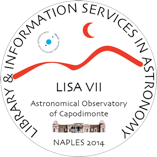
EDP Sciences and A&A are pleased to announce their sponsoring “LISA VII, Open Science at the Frontiers of Librarianship” (Naples, 17-20 June 2014).
Library and Information Services in Astronomy (LISA) is a series of scientific meetings for librarians and scientists that aims to provide a platform to discuss state-of-the-art maintenance, retrieval, delivery, and preservation of information, and to learn from invited experts in which direction our profession is evolving.
LISA conferences cover a variety of topics such as the organization and management of books, journals, and specialized materials; electronic publishing (note that astronomy is a leader in the field); bibliographic and full text databases of astronomical literature; and reports on collaborative projects.
The A&A authors have the possibility of being identified with non-Roman alphabets, such as Chinese, Japanese, Cyrillic characters (November 2013)
- Details
- Published on 22 November 2013
A&A offers authors the possibility of being identified with non-Roman alphabets, such as Chinese, Japanese, Cyrillic characters. These names will be in parentheses after the English names displayed in the print issue and the online PDF.
(see specific instructions here)
All A&A articles are in open access ONE year after their publication date (August 2013)
- Details
- Published on 20 August 2013
EDP Sciences and the editorial board of A&A has the pleasure to announce that all Astronomy & Astrophysics articles are now in open access ONE year after their publication date, rather than two years. The main objective is timeliness of dissemination to scientists, while maintaining the quality of the information.
2012 Impact Factor (July 2013)
- Details
- Published on 25 June 2013
The Astronomy & Astrophysics ISI impact factor for 2012 is 5.084
Astronomy & Astrophysics articles were cited 101,305 times in 2012.
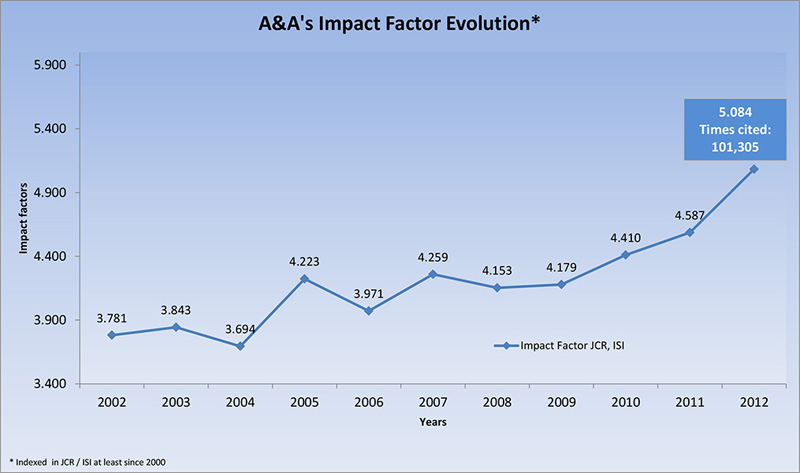
A&A at the XXVIII General Assembly of the IAU (August 2012)
- Details
- Published on 21 August 2012
A&A has a booth on the XXVIII General Assembly of the IAU held in Beijing from 20 to 31 August and is the sponsor of the poster session.
A&A is also part of the “Workshop for Journal Authors and Referees” at the XXVIII General Assembly of the IAU.
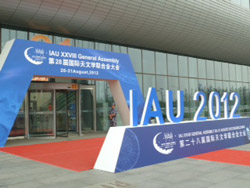
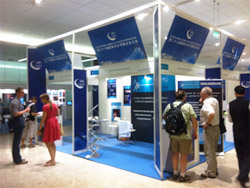
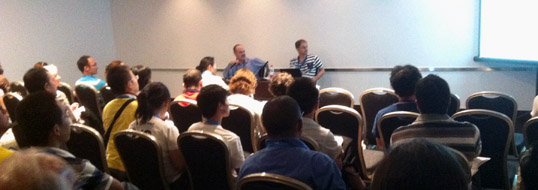
Announcement from the A&A Board of Directors: Call for Candidates for Letters Editor-in-Chief of A&A (September 2012)
- Details
- Published on 21 August 2012
The Board of Directors of A&A invites applications for the position of Letters Editor-in-Chief, which will become vacant on 1 February, 2013.
Candidates are expected to have a broad and strong record of published influential research in astronomy and astrophysics, and previous experience in scientific publishing. The successful candidate will show a strong interest in developing and promoting the Journal, and will also possess the interpersonal skills needed to work closely together with a team of Editors.
Candidates should be prepared to commit the time needed to handle the A&A Letters Section and as well work as scientific editor of a number of manuscripts. The Letters Editor-in-Chief (LEiC) has the overall responsibility for the Letters Section and works closely with the Editor-in-Chief (EiC).
Support for office equipment and secretarial help, as well as an annual indemnity, is provided for this position. The initial term of appointment is four years.
Applicants should submit a curriculum vitae, a list of publications, and a letter of intent summarising the candidate’s qualifications and motivation for seeking the position of Letters Editor-in-Chief. Possible support for the task from the candidate’s home institute in terms of equipment, office space or personnel should also be outlined in the application.
Applications should be sent by e-mail in PDF format to the Chairperson of the Board of Directors, with a copy to the Vice-Chairperson. Prompt acknowledgement of receipt will be given. Informal inquiries about the position may be directed to the Chairperson or Vice-Chairperson of the Board or to the Editor-in-Chief (see below). Applications received by 10 November 2012 will receive full consideration.
Read the PDF version of Announcement from the A&A Board of Directors, A&A 545, E1 (2012)
2011 Impact Factor (July 2012)
- Details
- Published on 29 June 2012
The Astronomy & Astrophysics ISI impact factor for 2011 is 4.587.
Astronomy & Astrophysics articles were cited 90,096 times in 2011.
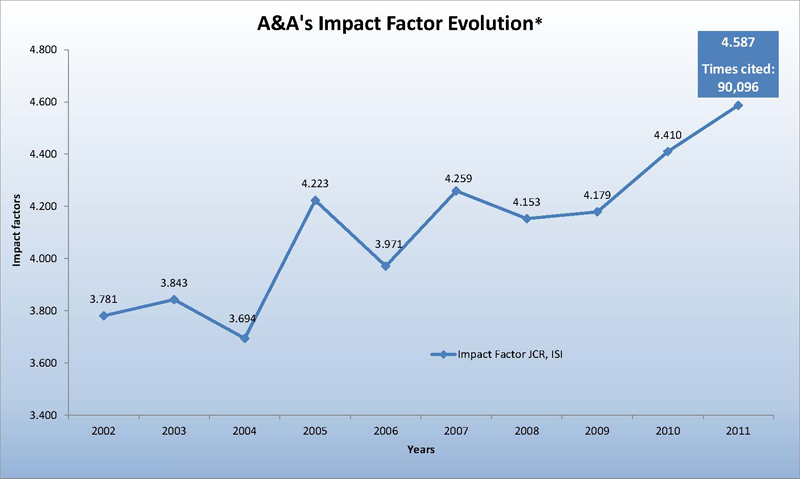
* Indexed in JCR / ISI at least since 2000.
A reduced Open-Access embargo period for A&A (June 2012)
- Details
- Published on 04 June 2012
All Astronomy & Astrophysics articles are now in open access two years after their publication date, rather than two years after the end of the calendar year of their publication. This reduces the open-access embargo period for the journal by an average of six months.
“Workshop for Journal Authors and Referees” at the XXVIII General Assembly of the IAU (April 2012)
- Details
- Published on 10 April 2012
The major astronomical journals in North America and Europe are co-sponsoring a workshop for journal authors and referees at the XXVIII General Assembly of the IAU. The workshop is aimed mainly at young astronomers and astronomers from Asian and developing countries.
The workshop is made possible by the support and cooperation of the American Astronomical Society, the Astronomical Society of the Pacific, EDP Sciences, the Institute of Physics Publishing, the Royal Astronomical Society, and Wiley Blackwell, as well as by Astronomy & Astrophysics and the journals of the AAS, ASP, and RAS.
 |
 |
 |
 |
 |
 |
 |
Workshop Dates
The workshop will extend over one full day. It will be repeated on four different days during the General Assembly: Wednesday 22 August, Friday 24 August, Monday 27 August, and Wednesday 29 August. The content of the workshop on each of the days will be identical.
To registerA&A is now available in a mobile-optimized format (March 2012)
- Details
- Published on 08 March 2012
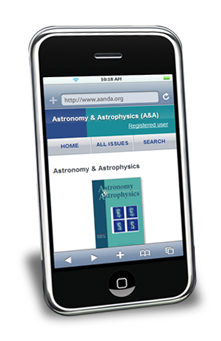
All visitors using either their smartphone or their tablet device will be automatically redirected to the mobile version of the Astronomy & Astrophysics website.
The mobile A&A site offers an easy access to current and archive content, and a quick search function.
Subscribers can now view content in a format designed specifically for their mobile device.
Astronomy & Astrophysics sponsors IAU General Assembly poster session (January 2012)
- Details
- Published on 10 January 2012

|
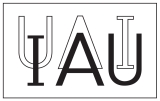
|
Astronomy & Astrophysics is proud to inform you of its poster sponsorship of the IAU General Assembly which will be held in China, Beijing, from August 20-31, 2012.
IAU's General Assembly, held every three years, will bring together an expected 3,000 astronomers from all over the world to China and Beijing to present and discuss the latest breakthroughs in astronomy.
Over two weeks in August 2012, the General Assembly will address many timely topics and the latest scientific discoveries in a number of specialized areas. With 8 Symposia, 7 Joint Discussions and 18 Special Sessions, the General Assembly's scientific program will be broader than ever.
Attendance at the IAU XXVIII General Assembly (GA2012) is open to all Individual Members of the IAU. Students of astronomy and professional astronomers who are not IAU-members are equally welcome to attend. Upon submitting their registration, they will be issued an invitation from the IAU.
2010 Impact Factor (July 2011)
- Details
- Published on 22 August 2011
The Astronomy & Astrophysics ISI impact factor for 2010 is 4.410.
Astronomy & Astrophysics articles were cited 89,585 times in 2010.
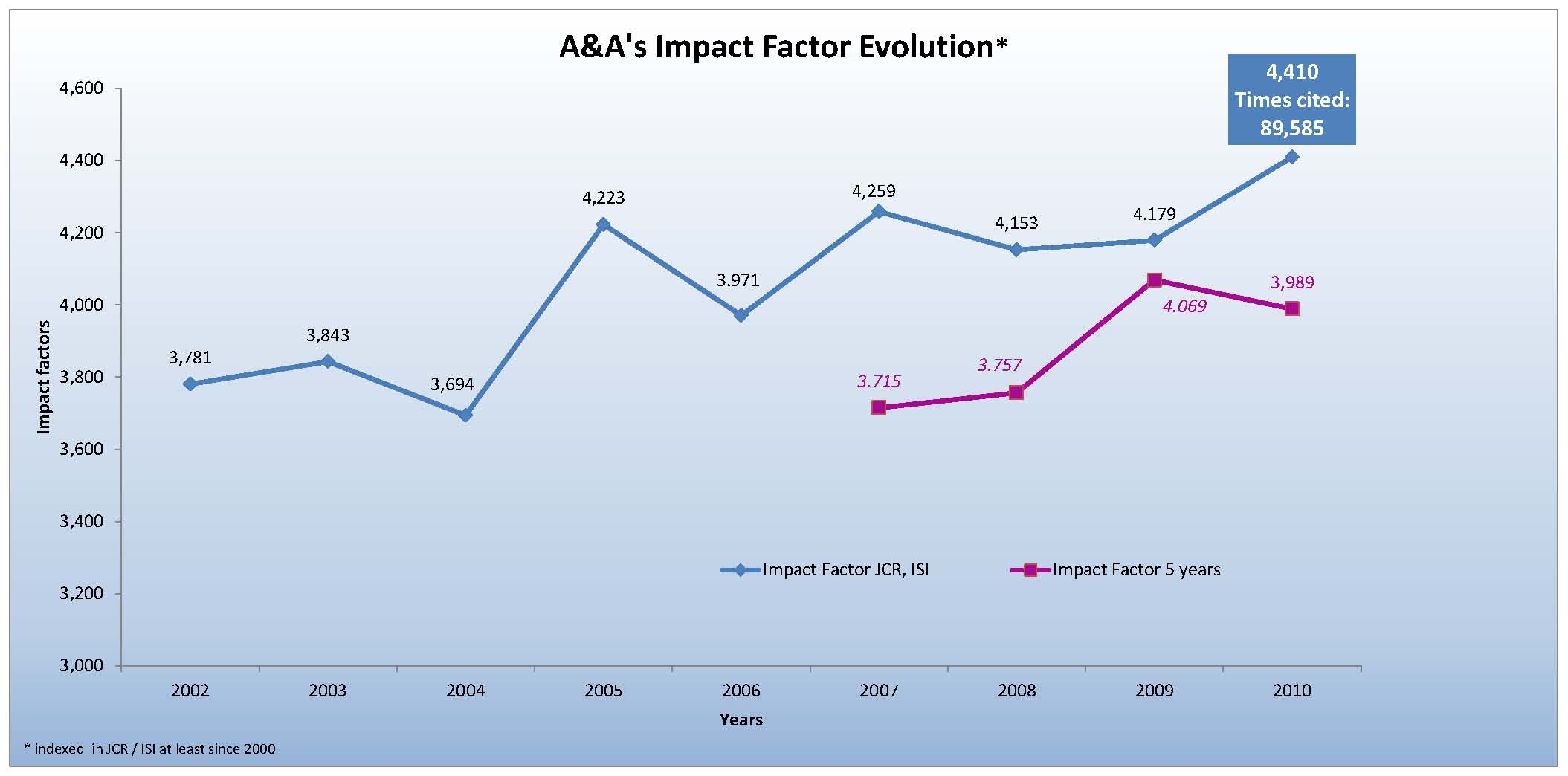
Ilkka Tuominen In Memoriam (May 2011)
- Details
- Published on 27 May 2011
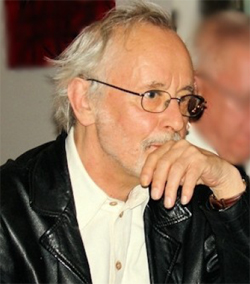
It is our sad duty to announce the sudden loss of the Finnish representative to the A&A board from 1998 until his death on March 19, 2011, at his home in Helsinki.
Illka Tuominen is a well-known astronomer, who was deeply appreciated for his achievements in Finland and internationally as described in detail by here.
Announcement from the A&A Board of Directors: Call for candidates for Editor-in-Chief of A&A (May 2011)
- Details
- Published on 25 May 2011
The Board of Directors of A&A invites applications for the position of Editor-in-Chief, which will become vacant on January 1, 2012.
Candidates are expected to have a broad and strong record of published influential research in astronomy and astrophysics, and previous experience in scientific publishing. The successful candidate will show a strong interest in developing and promoting the Journal, and will also possess the interpersonal skills needed to lead the editorial team and handle the occasional conflicts that occur during the peer-review process …
Read the Announcement from the A&A Board of Directors, A&A 530, E1 (2011)
This is a free access article
Free access to Astronomy & Astrophysics articles 24 months after publication instead of 36 months previously (January 2011)
- Details
- Published on 31 January 2011
EDP Sciences and A&A favor a broad and easy access to all published scientific information. In this spirit, all Letters to the Editor and articles published in the online sections (Sects. 12, 13, 14, and 15) are already in full open access.
We are pleased to announce that all articles published in the other sections of the Journal are now freely accessible one year earlier: 24 months instead of 36 months previously. So, all articles published in 2008 are now in free access.
2010 "School meets Science" prize for Beuermann et al. (2009) (September 2010)
- Details
- Published on 01 October 2010
Astronomy & Astrophysics is proud to report that the German high-school program that led to a Research Note (Beuermann et al. 2009, A&A, 507, 385), and highlighted in an A&A press release has won the Bosch Foundation "School meets Science" prize for 2010.
2009 Impact Factor (June 2010)
- Details
- Published on 18 June 2010
The Astronomy & Astrophysics ISI impact factor for 2009 is 4.179.
Astronomy & Astrophysics articles were cited 88,679 times in 2009.
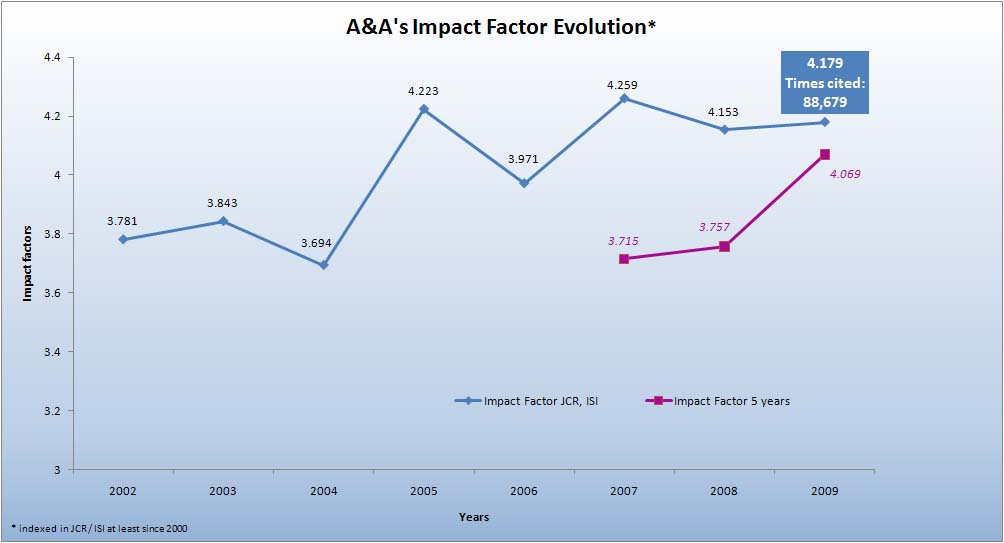
Introducing structured abstracts for A&A articles (October 2005)
- Details
- Published on 09 May 2010
Astronomy & Astrophysics introduces structured abstracts for A&A articles.
See Editorial, A&A 441, E3 (2005)
Two Associate Editor positions to be filled (March 2010)
- Details
- Published on 24 March 2010
A&A 512, E1 (2010), Letter from the A&A Board of Directors (PDF file)
The Board of Directors invites applications for two positions of A&A Associate Editors. The positions to fill are in the following
research areas:
– Observational studies of extragalactic systems and of Galactic structure, clusters, and populations;
– Stellar astrophysics.
The new Associate Editors are expected to have a broad and recognized expertise in their domain of specialization, as witnessed by a strong record of influential published research. For the stellar astrophysics position, preference will be given to candidates with expertise in both theory and observations.
Candidates should be prepared to commit the time needed to handle the peer review of about two hundred papers per year. Limited support for office equipment and secretarial help, as well as an annual indemnity, is provided for this position. The initial term of appointment is four years.
Applicants should submit a curriculumvitae, a list of publications, and a concise letter that summarizes the candidate’s qualifications and the reasons for seeking an Associate Editor position. They should in particular describe their experience as a referee and/or journal editor. Possible support for the task (in terms of equipment, office space or personnel) from the home institute should also be discussed in the application. Applications should be e-mailed in PDF format to the Chairman or the Vice-Chairman of the Board of Directors, who will send back an acknowledgment of receipt.
Chairman Dr. Georges Meynet
Geneva Observatory
CH-1290 Sauverny
Switzerland
e-mail: This email address is being protected from spambots. You need JavaScript enabled to view it.
Fax: +41 22 37 92205
Vice-Chairman Dr. Klaas S. de Boer
Argelander Institut f¨ur Astronomie
Auf dem H¨ugel 71
D-53121 Bonn
Germany
e-mail: This email address is being protected from spambots. You need JavaScript enabled to view it.
Tel.+49-228-733655
Applications received by 31 May 2010 will receive full consideration. Informal inquiries about the positions may be directed by e-mail to Georges Meynet or Klaas S. de Boer.
A&A makes the transition to article-numbering (January 2010)
- Details
- Published on 12 January 2010
The Editorial on the transition to article numbering can be consulted in A&A, vol. 509, E1, 2010.
Quick dissemination of validated science results is an important aspect of academic publishing. Over the years, the electronic
editions of journals have become the primary vehicle for achieving that objective. With the new contract period for publishing
A&A, the preparation of the electronic edition is being optimized for speed of publication.
To streamline the production of the Journal, it has appeared useful to change from the classical "page-numbering system" to a
more flexible "article-numbering system". This means that, as of January 2010, articles will be marked according to their class of
publication using a roman letter: L for Letter, A for Article, E for Editorial, C for Corrigendum, etc. Furthermore, the articles of
each class of publication will be given a number in the volume based on the sequence in which they are ready for publication in that
volume of A&A.
Published manuscripts will thus be numbered in A&A with a number preceeded by a roman letter signifying the publication
class. The result is that they will appear in A&A as, e.g.,
A&A 512, L1 for the Letter that is published first in Volume 512
A&A 512, A12 for the twelfth published article in the same volume
A&A 512, A13 for the thirteenth published article, and so on.
A&A 512, L1 (2010) and A&A 512, A12 (2010).
The page numbering will be internal to each manuscript, i.e., the first page of each paper will always be numbered as 1. The page number will be located at the bottom of each page and will take the form "Page n out of N" where N is the total page number of the manuscript and 1 ≤ n ≤ N.Finally, the paper’s reference will be repeated as the running title of even-numbered pages while the running title of oddnumbered pages will be left unchanged.
The manuscripts accepted for publication will appear in the currently opened A&A volume as soon as they are ready to become public. A&A users will also be able to see on the Journal website how the open volume is being filled up every day with newly published manuscripts. At the closure date of the volume, its contents will be sent to the printer. The printed volumes of A&A will contain the publications in the sequence E1, E2, etc., L1, L2, L3, etc., A1, A2, A3, etc. However, the A&A website and the table of contents of each volume will display the published papers in the usual manner, with a table of contents sorted by sections.
Authors do not need to worry about the changes, since everything will be taken care of in the editorial and production process.
Citing an article will be in a format only slightly different from earlier since there will always be a capital letter in front of the last number. For Letter number 4 and article number 12 in Volume 552, the references will be as follows.
Writer, U.V., & Author, B. C. 2010, A&A, 552, L4
Author, B. C. 2010, A&A, 552, A12
Color printing special offers extended (December 2009)
- Details
- Published on 04 December 2009
Our color printing special offers have been extended until the end of 2010. Continue benefiting from these exceptional reductions:
- Free for letters: figures (for which electronic files are provided in color) are published in color free of charge in the paper version;
- 50% reduction on the color figure prices for regular papers.
Astronomy & Astrophysics present at IAU General Assembly (September 2009)
- Details
- Published on 11 September 2009
At the recent XXVIIth General Assembly of the IAU, held in Rio de Janeiro from 3rd to 14th August 2009, Astronomy & Astrophysics had a stand where scientists met and chatted with staff from our journal. The conference was an opportunity to celebrate the 40th anniversary of Astronomy & Astrophysics and to present a special issue illustrating the journal’s scientific voyage through a collection of excellent articles published over the last forty years. The activities organized during the conference included an effort to bring the journal closer to its readership, and for that purpose, members of the Board of Astronomy & Astrophysics, including its chairman, Prof. G Meynet, and Dr. F. Combes and Dr. B. Nordström, organized a presentation of the journal, its results, and its ambitions. The journal also sponsored the poster session held alongside the conference.
The Astronomy & Astrophysics Board, its editorial team, and the team in charge of the journal at EDP Sciences hope that this opportunity for a dialogue between a journal and its community of authors and readers was beneficial to everyone concerned!
More Articles...
- 2008 Impact factor (July 2009)
- Summaries of recent Board meetings
- ESO and EDP Sciences sign new contract for Astronomy and Astrophysics (June 2009)
- Astronomy & Astrophysics sponsors IAU General Assembly poster session (March 2009)
- New platform (1.7 version) (Feb. 2009)
- 2nd Astronomy and Astrophysics School: Scientific Writing for Young Astronomers (Jan. 2009)
- Astronomy & Astrophysics at Opening ceremony of the International Year of Astronomy (Jan. 2009)
- Color printing special offers extended (October 2008)
- Open Access Option for A&A (October 2008)
- English language editing at A&A (October 2008)





